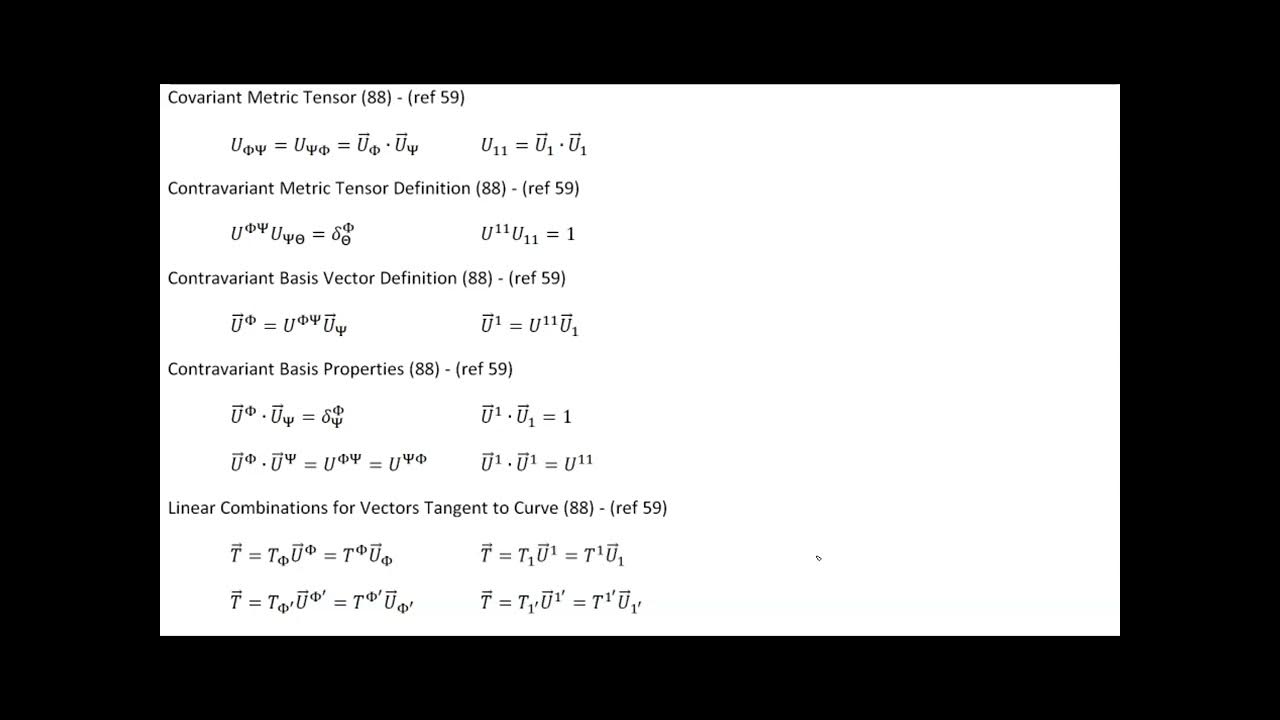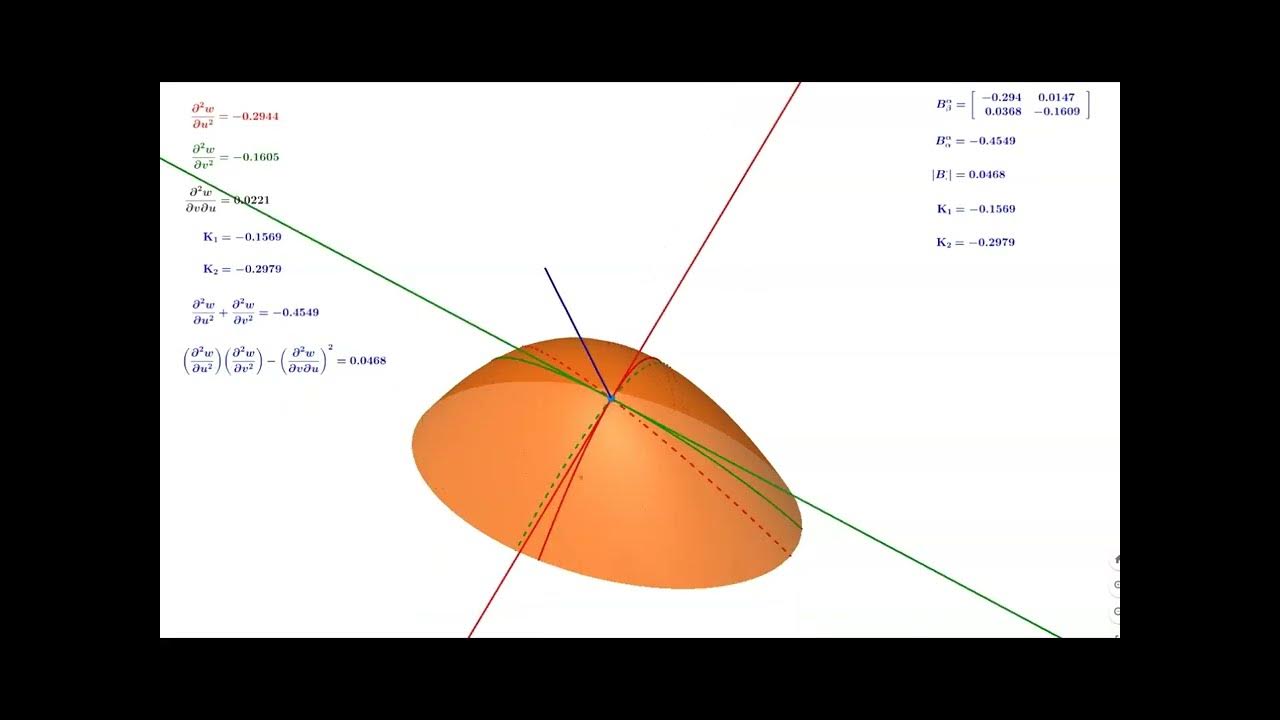Tensor Calculus Lecture 14c: Non-hypersurfaces - Relationship Among The Shift Tensors
TLDRThis video script delves into the concept of principal curvatures, essential in understanding curves and surfaces in higher-dimensional spaces. It emphasizes the importance of coordinate systems and the differentiation of identities to explore the relationships between embedded manifolds. The script introduces the shift tensor and metric tensor, highlighting their roles in connecting the curve, surface, and ambient space. The ultimate goal is to derive principal curvatures through covariant differentiation, providing a foundational understanding of curvature in differential geometry.
Takeaways
- 📚 The script discusses the concept of principal curvatures, which is related to curves embedded in surfaces within an ambient space.
- 🔍 Principal curvatures arise from differentiation of identities, and the script aims to establish an appropriate identity for this purpose.
- 📏 The script introduces different coordinate systems for the ambient space (Z), the embedded surface (S with coordinates S_α), and the curve within the surface (with coordinates u and indices represented by capital Greek letters).
- 📈 The dimensionality of the embedded structures is general and not limited to three dimensions, allowing for higher-dimensional spaces and manifolds.
- 🌐 The script emphasizes the importance of maintaining tensor indices even when they take on the same value, as their placement carries essential information for tensor calculus.
- 🔗 It discusses three types of embeddings: the surface within the ambient space, the curve within the surface, and the curve within the ambient space, each with its own coordinate system.
- 🔑 The script introduces the identity that relates the equation of the curve in the ambient space to the equation of the surface and the curve within the surface.
- 📝 The identity is differentiated using the chain rule, leading to the introduction of the shift tensor of the curve in the ambient space and its relationship to the shift tensors of the surface and curve.
- 🔑 The relationship between the shift tensors is likened to a chain rule and involves the contraction of the shift tensor from space to surface with the shift tensor from surface to curve.
- 📚 The script suggests that from the established relationships, one can derive connections between metric tensors of the curve, surface, and ambient space.
- 🔍 The ultimate goal of the script is to derive principal curvatures, which are second-order relationships, from the first-order relationships established by the differentiation process.
Q & A
What is the concept of principal curvatures?
-Principal curvatures are a concept in differential geometry that describe the curvature of a surface at a given point. They are the eigenvalues of the shape operator or second fundamental form and provide information about the surface's shape, such as how it bends in different directions.
Why is the concept of principal curvatures important in the study of surfaces?
-The concept of principal curvatures is important because it helps in understanding the intrinsic geometry of a surface. It allows for the analysis of how a surface bends and curves in the ambient space, which is essential in various fields such as computer graphics, physics, and engineering.
What are the different coordinate systems mentioned in the script?
-The script mentions three different coordinate systems: Z for the ambient space, which could be three-dimensional or higher; S for the embedded surface, which is typically two-dimensional in a three-dimensional space; and u for the curve embedded within the surface, which is one-dimensional.
Why is it necessary to use different alphabets for different dimensions in the script?
-Different alphabets are used for different dimensions to avoid confusion and to clearly indicate the hierarchy of embeddings. For example, Greek letters are used for the indices of the curve embedded within the surface to distinguish them from the indices of the surface itself.
What is the significance of the tensor framework in the context of the script?
-The tensor framework is significant because it provides a mathematical language to describe the relationships between different coordinate systems and the properties of the embedded surfaces and curves. It allows for the manipulation of indices and the construction of invariant objects, which are essential for generalizing the concepts across different dimensions.
What is the role of the shift tensor in the script?
-The shift tensor plays a crucial role in relating the different embeddings. It describes how a curve is embedded within a surface and how the surface is embedded within the ambient space. The script discusses how the shift tensor of the curve with respect to the ambient space can be expressed in terms of the shift tensors of the surface and the curve.
How does the script relate the embeddings of the curve, surface, and space?
-The script relates the embeddings by expressing the equation of the curve in the ambient space in terms of the equation of the surface and the curve within that surface. This relationship is an identity that can be differentiated to explore the properties of the embeddings, such as the shift tensors and metric tensors.
What is the purpose of differentiating the identity involving the embeddings?
-Differentiating the identity involving the embeddings allows for the exploration of the relationships between the properties of the curve, surface, and space at a deeper level. It is a method to derive higher-order relationships, such as the principal curvatures, from the first-order relationships described by the shift tensors.
What is the difference between intrinsic and extrinsic properties in the context of the script?
-Intrinsic properties are those that can be described without reference to an external space, such as the metric tensor on a surface. Extrinsic properties, on the other hand, involve the embedding of the surface or curve in a larger space, such as the shift tensor that describes how a curve is embedded within a surface.
How does the script suggest approaching the problem of finding principal curvatures?
-The script suggests starting by writing down an appropriate identity that relates the embeddings of the curve, surface, and space. Then, by differentiating this identity using the chain rule and the covariant derivative on the curve, one can derive the principal curvatures, which are second-order properties of the surface.
What are the implications of considering a curve embedded in a higher-dimensional space?
-Considering a curve embedded in a higher-dimensional space allows for a more general understanding of the concepts discussed in the script. It means that the methods and relationships derived can be applied to a wide range of scenarios, not just to the common case of a curve in three-dimensional space.
Outlines
📚 Introduction to Principal Curvatures
The script begins by introducing the concept of principal curvatures, which relate to the curvature of curves embedded in surfaces within a higher-dimensional ambient space. The concept is approached through the differentiation of identities, necessitating an understanding of various coordinate systems and relationships. The ambient space is denoted by coordinates Z, the embedded surface by S and its coordinates by S Alpha, and the curve within the surface by capital Greek letters, emphasizing the dimensional hierarchy and the generality of the concepts across different dimensions. The script also discusses the embeddings of manifolds and the importance of maintaining tensor calculus principles despite the indices having the same value.
🔗 Relationship Between Embeddings and Shift Tensors
This paragraph delves into the relationship between the curve, surface, and ambient space, highlighting how the equation of the curve embedded in space can be expressed through the equation of the surface and the curve within that surface. The identity formed is then differentiated using the chain rule, leading to the introduction of the shift tensor of the curve in the overall space, denoted as z_i^fi, which is a new object but essentially the shift tensor discussed in previous videos. The paragraph also touches on the relationship between the metric tensors and how they can be related through this identity, setting the stage for further exploration into principal curvatures.
🔍 Transition to Second-Order Relationships and Curvatures
The final paragraph shifts focus from first-order relationships to second-order ones, specifically curvatures. It suggests applying the covariant derivative on the curve, using the coordinates on the curve as independent variables, to derive mean curvatures. The paragraph hints at the productive nature of this approach over simple partial differentiation and indicates that the curvatures will be the main focus moving forward, as they are a critical aspect of differential geometry.
Mindmap
Keywords
💡Principal Curvatures
💡Differential Geometry
💡Embedded Surfaces
💡Ambient Space
💡Tensor Calculus
💡Shift Tensor
💡Metric Tensor
💡Covariant Derivative
💡Chain Rule
💡Intrinsic vs. Extrinsic
💡Manifold
Highlights
Introduction to the concept of principal curvatures in relation to curves and surfaces in ambient space.
Exploration of the necessity of differentiating identities to derive the concept of principal curvature.
Discussion on the importance of coordinate systems and their relationships in the context of embedded surfaces and curves.
Introduction of the notation Z for coordinates in the ambient space and S for coordinates on the embedded surface.
Clarification on the dimensionality of the embedded surfaces and curves, emphasizing the generality of the concepts presented.
Introduction of the capital Greek alphabet for indices to differentiate between the dimensions of the ambient space, surface, and curve.
Explanation of the tensor framework and the significance of index placement in tensor calculus.
Description of the three types of embeddings: curve in surface, surface in space, and curve in space.
Emphasis on the generality of the terminology 'surface' and 'curve' to indicate hierarchy rather than dimensionality.
Introduction of the relationship between the embeddings through the equation of the curve within the surface and space.
Invitation to the audience to pause the video and attempt to derive the identity for differentiation themselves.
Derivation of the shift tensor of the curve in the overall space as a product of shift tensors from space to surface and surface to curve.
Discussion on the relationship between metric tensors and how they can be related through the embeddings.
Introduction of the goal to reach principal curvatures through second-order relationships derived from the given identity.
Explanation of the process of applying the covariant derivative on the curve to derive principal curvatures.
Note on the availability of detailed relationships between metric tensors in the book, suggesting it as an exercise for the audience.
Final focus on the derivation of mean curvatures as a first-order relationship, setting the stage for further exploration of curvatures.
Transcripts
Browse More Related Video

Tensor Calculus Lecture 8c: The Curvature Tensor On The Sphere Of Radius R

Tensor Calculus Lecture 14a: Non-hypersurfaces

Tensor Calculus Lecture 15: Geodesic Curvature Preview

Video 88 - Embedded Curves - Part 1

Tensor Calculus Lecture 14e: Non-hypersurfaces - Relationship Among Curvature Tensors 2

Video 80 - Curvature Tensor - Part 2
5.0 / 5 (0 votes)
Thanks for rating: